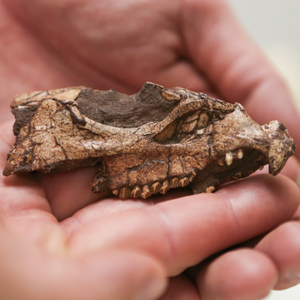The museum’s Aquilops skull, which is about the size of a lemon, recently returned home to Norman after a trip to the Fukui Prefectural Dinosaur Museum in the city of Katsuyama in Japan’s Fukui Prefecture. Acting as a bodyguard of sorts, the Sam Noble Museum’s fossil preparator, Kyle Davies, escorted the original skull to and from the Japanese museum, where it was shown in the temporary exhibit "The Great Journey of Dinosaurs,” which was on display July 8 through Oct. 10.
The special exhibit demonstrated the interchange of dinosaurs between Asia and North America, focusing on tyrannosaurs, or bipedal carnivores whose name translates to “tyrant lizards,” and ceratopsians, the group of herbivorous, horned dinosaurs. Tyrannosaur fossils have been found only in North America and Asia, and ceratopsian fossils have been found only in North America, Europe and Asia.
“That’s where Aquilops comes in,” Davies said. “He’s the earliest ceratopsian known from North America. When you look at the ceratopsian family tree, his closest relatives were in China, indicating that there had to be some sort of connection between North America and China sometime before this guy appears here in North America.”
About Aquilops
A team of paleontologists led by Rich Cifelli, Sam Noble Museum’s curator of vertebrate paleontology, unearthed the beak-nosed dinosaur in southern Montana during a 1997 expedition funded by the National Geographic Society’s Committee for Research and Exploration. Aquilops is now considered the oldest named member of the horned dinosaur lineage from North America and provides important new information on vertebrate history during the latter part of the age of dinosaurs.
Aquilops americanus (meaning “American eagle face”) represents a 3-pound relative of Triceratops, which weighed up to 4,000 times more. A “no frills” ceratopsian, Aquilops also lacks the trademark head shield and facial horns of its distant cousins. Roughly the size of a small cat, it is estimated to have been 2 feet long — another point of contrast with its truck-sized relatives.
The expedition team’s findings were published in the Dec. 10, 2014, issue of the scientific journal PLOS ONE. Andrew Farke, a paleontologist from the Raymond M. Alf Museum of Paleontology in Claremont, California, and a specialist on horned dinosaurs, acted as lead on the study.
The fossil record suggests that horned dinosaurs arose in Asia and dispersed to North America via a land-bridge at the present-day Bering Strait by about 108 million years ago, the age of Aquilops. Surprisingly, however, the study by Farke and colleagues places Aquilops near the base of the ceratopsian family tree, far removed from horn-bearing Triceratops and other North American relatives. Relationships among these upper branches of the genealogical tree suggest that two or more additional immigration events happened later in the Cretaceous.
Museum Partnership
In 2015, the Aquilops skull found its new home in an exhibit inside the Sam Noble Museum’s Hall of Ancient Life alongside the museum’s Pentaceratops, which holds the Guinness World Record for being the largest dinosaur skull ever found. The Aquilops display shows three versions of the skull: the original fragmentary skull and jaw, a skull and jaws with missing parts restored, and a computer-generated, complete and undistorted 3D reconstruction.
The Fukui Prefectural Dinosaur Museum mimicked this three-version display in its special exhibit to help educate the public about the condition in which fossils are found and their transformation into display specimens, Davies said.
“When you’re looking at fossils, you shouldn’t think of nice, pristine skeletons; you should think of roadkill, because geologic forces like the compression of the sediments usually crush the things, distorting their shape,” he said. “When you’re thinking about them and analyzing these animals, you have to undistort them.”
And that’s exactly Davies’ specialty: As a museum preparator, he prepares vertebrate fossils for scientific research and education.
Davies, a Japanophile, was elated to make two trips to the Fukui Prefectural Dinosaur Museum for the Aquilops skull’s arrival and departure, and to facilitate an international loan of an important holotype (a specimen forming the basis for a species name).
He said he found the museum’s origins particularly fascinating. Although you’re much less likely to find dinosaur fossils in a highly vegetated place such as Japan, a quarry just 15 minutes away from the dinosaur museum has proved fruitful in producing specimens. Those include a sauropod, Fukuititan; two iguanodonts, Fukuisaurus and Koshisaurus; and two theropods, Fukuiraptor and Fukuivenator.
“I learned a lot about their museum through this partnership,” Davies said of the museum that’s dedicated solely to dinosaurs. “I got into all this as a little kid because I was excited about dinosaurs, so what can I say? It was fun and interesting to see a different museum over there and how elaborate it can actually get.”



